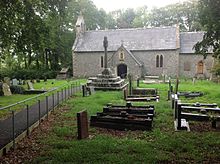Saint Canna
Canna | |
|---|---|
 St Canna's Church, Llangan | |
| Died | 6th century Wales |
| Feast | 25 October |
Canna was a sixth-century mother of saints and later a nun in south Wales, to whom two Welsh churches are dedicated.
Life
[edit]According to the writings of the unreliable Iolo Morganwg, Canna was a daughter of King Tewdwr Mawr of Armorica (modern-day Brittany) and Cornwall. She was the mother of Crallo and Elian.[1]
Canna was reputedly the sister-in-law and cousin of Illtud, and possibly established the church at Llangan, near Llantwit, due to its proximity to him. She married Sadwrn, her first cousin or uncle; together they accompanied Saint Cadfan to Britain and founded two churches, one in Carmarthenshire and another in Anglesey.[2]
Veneration
[edit]
At St Canna's Church in Carmarthenshire, there was a holy well below the old church called Ffynnon Ganna, whose water was believed to have curative properties and was a site of pilgrimage for many centuries. The holy well is no longer extant. There was also a stone known as Canna's Chair, with an undated inscription possibly reading CANNA, in a field near the churchyard.[2]
Her name also appears as part of two Cardiff districts: Canton (English translation of the Welsh Treganna, Saint Canna's Town); and Pontcanna (Welsh for Canna's Bridge).[3]
Canna's feast day is celebrated on 25 October.[4]
References
[edit]- ^ Price, Thomas (1848). Iolo Manuscripts: A Selection of Ancient Welsh Manuscripts, in Prose and Verse, from the Collection Made by the Late Edward Williams, Iolo Morganwg, for the Purpose of Forming a Continuation of the Myfyrian Archaiology; and Subsequently Proposed as Materials for a New History of Wales. W. Rees; sold by Longman and Company, London. pp. 534, 536.
- ^ a b Archaeologia Cambrensis: a record of the antiquities of Wales and its Marches and the journal of the Cambrian Archaeological Association. Vol. 3 (4th ed.). Cambrian Archaeological Association. January 1872. pp. 235–239.
- ^ "The Placenames of the Cardiff District". Reports and Transactions. Vol. 32–33. Cardiff Naturalists' Society. 1901. p. 39.
- ^ Jones, David Daven (1910). The Cymry and their church. Carmarthen: W. Spurrell. pp. 114–115.
Text is available under the CC BY-SA 4.0 license; additional terms may apply.
Images, videos and audio are available under their respective licenses.
